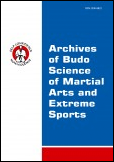2015, Volume 11, Issue 1
Pulling forces in different judo stances in laboratory conditions
Semih Yilmaz1
1Faculty of Sport Sciences, Marmara University, Istanbul, Turkey
Author for correspondence: Semih Yilmaz; Faculty of Sport Sciences, Marmara University, Istanbul, Turkey; email: semihyilmaz[at]marmara.edu.tr
Full text
Abstract
Background and Study Aim: By constructing a judo specific force measurement device, the total pulling force in relation to left/right force components and stance variations of judo techniques was analysed. The aim of this study is knowledge about the global pulling force in relation to left/right force components and laterality of judo techniques measures in laboratory conditions (mimicked acting on the opponent as close as possible to the competition technique).
Material and Methods: Forty male elite judo athletes (age 20.1 ±0.9 years, weight 79.1 ±18.7 kg, height 174.2 ±8.1 cm). All were members of the national youth team. Athletes performed successively four different stance-pulling techniques all based on shizen-tai (natural standing posture) on the judo specific device. Three Load Cells (LC) recorded total and right/left side applied forces on the judogi. Force patterns were analysed according to technique, weight category, and body mass.
Results: For the whole group, in all four stances the produced total force was nearly equal ranging between 13.56 N/kg and 14.40 N/kg. The absolute force values increased with increasing body weight (p<0.05), the normalized forces values increased with decreasing body weight (p<0.001). In all four stances, the pulling force on the sleeve was greater than the pulling force on the collar independent from arm preference (p<0.05). Lightweight judokas showed a more balanced left/right force production, whereas for the heavy weight category the left-right difference was significant (p<0.05).
Conclusions: Body weight influenced force magnitudes as well as left/right balancing of force application. Heavier judokas implemented left/right asymmetries by greater force application on the sleeve regardless of arm preference of the tori during the technique. Adding rotational technique components by foot stance variations did not change force magnitude and pattern.
Key words: biomechanics, body posture, judo technique, load cells





